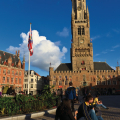BELFRY AND LINEN SHED
The belfry overhanging the building of the wool market, one of the symbols of Bruges, with a medieval architecture
The belfry, which towers above the wool and cloth market, is one of the symbols of Bruges. Its 88-meter-high tower was built in the 13th century in the square section, and at the end of the 15th century in the octagonal section. Belfries were a testament to the self-confidence of medieval cities. They are among the oldest examples of medieval civil and public architecture, and embodied the pride and prosperity of the city's bourgeoisie. Listed as a Unesco World Heritage Site for its historical importance and role in civil society, the belfry was fully restored in 2012. It's just 366 steps up: take heart, it's a great view!
History. In fact, the first construction dates back to 1240. It was a wool and cloth hall topped by a wooden tower intended for magistrates, but it was completely destroyed by fire, along with the town's first archives. It was at this time that the administration was moved to the new town hall. It was rebuilt in 1280, with two lower quadrangular brick sections supporting a wooden spire, and four turrets with stone spires. The former treasury housed the seals and charters of the medieval town until the 18th century. Then, between 1482 and 1486, as the market needed more space and the town's business flourished, the wooden spire was torn down to build a majestic octagonal tower of finely chiselled white stone in pure Brabantine Gothic style, flanked by four equally elaborate spires. Until 1741, a 19-metre-high pointed wooden structure with a statue of St. Michael still crowned the building, then the highest in Flanders ahead of that of Ghent. But in 1493, a fire destroyed it and some of the bells, which did not discourage the people of Bruges, who rebuilt it this time with lions climbing inside. Lightning struck again in 1741, and the church was repaired without the addition of a spire. It was finally decorated with a neo-Gothic crown in 1822. The hall beneath the tower was used by craftsmen to sell their fabrics. The treasure room upstairs housed the archives dating back to 1280, as well as the laws and regulations specific to Bruges: the Hallegeboden (in Dutch: les bans des Halles). These were proclaimed from the balcony above the entrance door, before the people who had been summoned by bells. In addition to being the official clock and a watchtower in case of fire, it was also a carillon that punctuated the lives of the inhabitants. Before the 16th century, bells were rung manually to open and close the town gates, as well as at the beginning and end of working hours. This official night-time curfew obliged residents to go out with a torch in the dark, as moving around at night was forbidden for safety reasons. In the event of imminent danger (fire, invasion...), tocsin bells were exceptionally rung in the air, as were festive bells, for example during the procession of the Holy Blood. From 1523 onwards, a clock-activated drum automated certain bells. It was at this time that secular and religious music began to be played, on Sundays, public holidays and market days.
The treasure room. On the second floor, the museum is housed in the former treasury, where the seals and charters of the medieval town were stored until the 18th century. Today, it's dedicated to the history of the belfry: take your time to learn about its construction and function in the Middle Ages.
The carillon. Take another step up the whirling spiral staircase and you're there. Try to synchronize yourself to watch the spectacle of the mechanisms clicking into place on the right floor just before the bells chime - it's quite an exciting and interesting experience. You'll certainly hear them, as they chime every quarter-hour. In 1675, the carillon consisted of 35 bells made by the Antwerp-born Melchior de Haze. Called "Duméry", it actually bears the name of the founder who replaced them after the fire in 1741 with 47 bells weighing a total of 27.5 tons. Just imagine the passion of the founders, passing on the medieval heritage and patiently tuning their little jewels of craftsmanship with their sharp ears. It's so massive that it's the most famous in Europe, thanks in particular to its "Victory" bell, which weighs no less than 8,814 kg. Placed in 1802, it requires 8 men to set it in motion. Carillon concerts take place from the belfry on Mondays, Wednesdays and Saturdays at 9pm and 10pm and on Sundays at 2pm and 3pm from mid-June to mid-September, and on Wednesdays, Saturdays and Sundays from 11am to 12pm from mid-September to mid-June.
The summit. On the5th floor, you'll be rewarded for your efforts. Don't count the steps - 366 would cut off your arms and legs. And don't pig out in the restaurant before the climb. At the end of the run, you'll enjoy the scenery, out of breath from the vertiginous ascent but content. On a clear day, the view is breathtaking over the city's rooftops and the medieval covered market (halles médiévales), testimony to the wealth of the period.
Book the Best Activities with Get Your Guide
Members' reviews on BELFRY AND LINEN SHED


Find unique Stay Offers with our Partners







